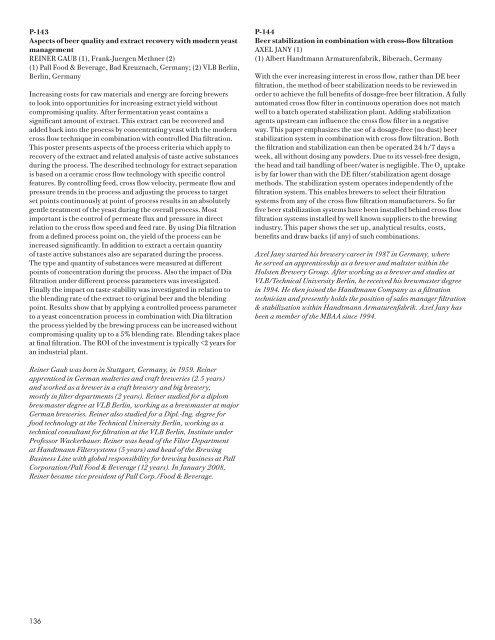Program Book - Master Brewers Association of the Americas
Program Book - Master Brewers Association of the Americas
Program Book - Master Brewers Association of the Americas
You also want an ePaper? Increase the reach of your titles
YUMPU automatically turns print PDFs into web optimized ePapers that Google loves.
P-143<br />
Aspects <strong>of</strong> beer quality and extract recovery with modern yeast<br />
management<br />
REINER GAUB (1), Frank-Juergen Methner (2)<br />
(1) Pall Food & Beverage, Bad Kreuznach, Germany; (2) VLB Berlin,<br />
Berlin, Germany<br />
Increasing costs for raw materials and energy are forcing brewers<br />
to look into opportunities for increasing extract yield without<br />
compromising quality. After fermentation yeast contains a<br />
significant amount <strong>of</strong> extract. This extract can be recovered and<br />
added back into <strong>the</strong> process by concentrating yeast with <strong>the</strong> modern<br />
cross flow technique in combination with controlled Dia filtration.<br />
This poster presents aspects <strong>of</strong> <strong>the</strong> process criteria which apply to<br />
recovery <strong>of</strong> <strong>the</strong> extract and related analysis <strong>of</strong> taste active substances<br />
during <strong>the</strong> process. The described technology for extract separation<br />
is based on a ceramic cross flow technology with specific control<br />
features. By controlling feed, cross flow velocity, permeate flow and<br />
pressure trends in <strong>the</strong> process and adjusting <strong>the</strong> process to target<br />
set points continuously at point <strong>of</strong> process results in an absolutely<br />
gentle treatment <strong>of</strong> <strong>the</strong> yeast during <strong>the</strong> overall process. Most<br />
important is <strong>the</strong> control <strong>of</strong> permeate flux and pressure in direct<br />
relation to <strong>the</strong> cross flow speed and feed rate. By using Dia filtration<br />
from a defined process point on, <strong>the</strong> yield <strong>of</strong> <strong>the</strong> process can be<br />
increased significantly. In addition to extract a certain quantity<br />
<strong>of</strong> taste active substances also are separated during <strong>the</strong> process.<br />
The type and quantity <strong>of</strong> substances were measured at different<br />
points <strong>of</strong> concentration during <strong>the</strong> process. Also <strong>the</strong> impact <strong>of</strong> Dia<br />
filtration under different process parameters was investigated.<br />
Finally <strong>the</strong> impact on taste stability was investigated in relation to<br />
<strong>the</strong> blending rate <strong>of</strong> <strong>the</strong> extract to original beer and <strong>the</strong> blending<br />
point. Results show that by applying a controlled process parameter<br />
to a yeast concentration process in combination with Dia filtration<br />
<strong>the</strong> process yielded by <strong>the</strong> brewing process can be increased without<br />
compromising quality up to a 5% blending rate. Blending takes place<br />
at final filtration. The ROI <strong>of</strong> <strong>the</strong> investment is typically



